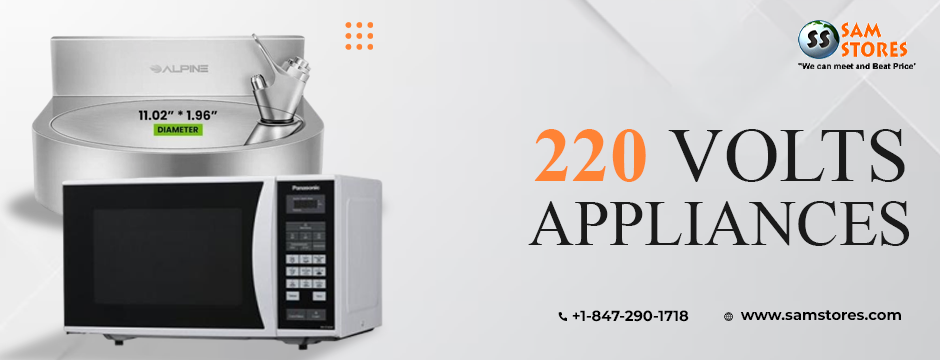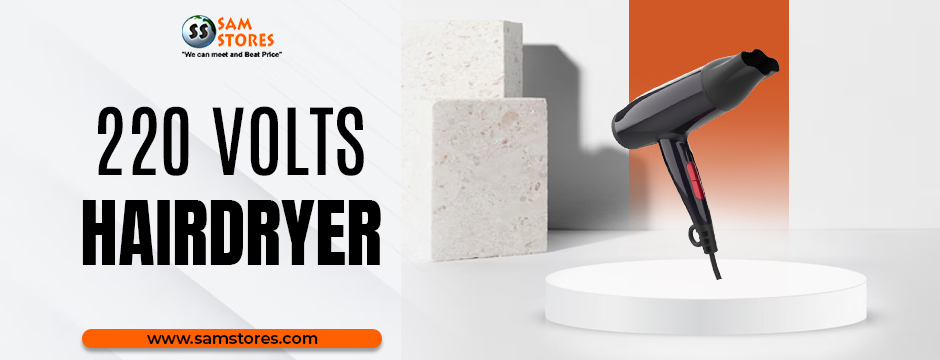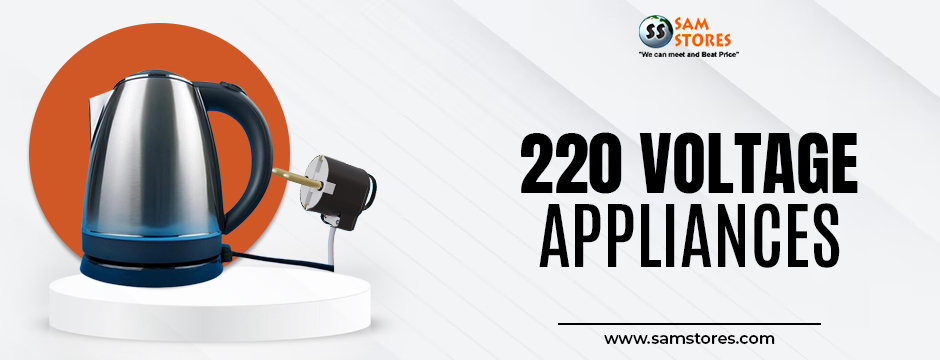Technology has reached a point where even the most ordinary household devices have begun to think for themselves. From air conditioners that learn your comfort habits to ovens that preheat with a voice command, the smart appliance wave is no longer a futuristic dream—it’s happening right now. For regions that rely on 220 volts electronics, the transition toward intelligent, connected living is unfolding faster than ever.
At Sam Stores, we’ve seen firsthand how this shift has transformed what customers expect from their 220 volts appliances. People no longer want machines that simply perform a task—they want devices that anticipate needs, save energy, and communicate seamlessly with other smart systems. Whether it’s in homes, commercial kitchens, or industrial facilities, smart 220 V technology is reshaping how we live and work.
Why 220 Volts Electronics Are the Global Standard
Before exploring what’s next in the smart appliance space, it’s important to understand why 220 voltage appliances dominate markets across Europe, Asia, and Africa.
Most countries in these regions use 220–240 volts as their standard for electricity distribution. Compared to the 110 V systems used in North America, 220 V allows for more efficient transmission of power over long distances and supports high-wattage devices with less current draw. This makes it ideal for heavy-duty machines like refrigerators, ovens, washers, and HVAC systems.
For manufacturers, this consistency creates an advantage. They can design more powerful and efficient 220 voltage electronics without worrying about high current losses or bulky wiring. For consumers, it means fewer limitations when integrating high-performance smart devices into their homes or businesses.
The Rise of Smart 220 Volts Appliances
The biggest trend sweeping through the 220 volts electronics market is connectivity. What began with Wi-Fi–enabled plugs and timers has evolved into full ecosystems where devices talk to each other, respond to real-time conditions, and even make independent decisions.
Here’s how “smart” is transforming traditional 220 volts appliances into intelligent partners in daily life.
1. Refrigerators That Think Ahead
Smart refrigerators are no longer limited to keeping food cool. They now monitor internal temperatures, track inventory, and send alerts when it’s time to restock. Some can even suggest recipes based on what’s inside.
For homes in Europe and Asia where energy efficiency standards are strict, these refrigerators adjust compressor speed and cooling cycles based on load and ambient temperature, minimizing electricity consumption without compromising freshness.
2. HVAC Systems That Learn Your Preferences
Air conditioners, heaters, and ventilation units powered by 220 V are getting smarter by the day. With IoT sensors and cloud-based learning, they can detect occupancy, outdoor climate, and even user mood through connected wearables.
The result is a personalized climate experience that keeps comfort levels optimal while cutting down on unnecessary energy usage. Industrial setups in Africa and the Middle East are using these same technologies to regulate large-scale cooling systems efficiently.
3. Smart Ovens and Cooking Systems
For modern kitchens, convenience and precision go hand in hand. Smart ovens operating on 220 voltage electronics can preheat remotely, adjust cooking modes automatically, and monitor food through internal cameras.
In commercial settings, predictive maintenance ensures that any irregularity—like overheating or uneven fan performance—is flagged before a breakdown occurs. For busy households or restaurants, this feature alone saves time, energy, and service costs.
Energy Efficiency: The Smart Advantage
One of the strongest selling points of smart 220 volts appliances is energy efficiency. As governments push for greener technologies, both homeowners and businesses are investing in devices that can lower consumption without sacrificing performance.
These appliances integrate sensors and AI-driven algorithms that constantly monitor usage. They can shut off power-hungry components when idle, adjust voltage flow during peak hours, and report real-time energy consumption via smartphone apps.
In regions like Europe, where electricity costs are rising, or in countries like India where grid stability fluctuates, these optimizations translate into real savings. Even modest efficiency gains can reduce monthly bills and extend the lifespan of the appliance itself.
Predictive Maintenance: Redefining Reliability
One of the most significant innovations in 220 voltage appliances is predictive maintenance. Instead of waiting for something to break, these systems use sensors and data analytics to predict failures before they happen.
For example, a connected washing machine might detect subtle vibrations that indicate a bearing issue long before it becomes a costly repair. A smart HVAC compressor can analyze temperature fluctuations and alert technicians about refrigerant leaks early on.
This proactive approach helps users—both residential and industrial—avoid unexpected downtime. For business owners relying on high-capacity 220 voltage electronics, this translates directly into higher productivity and fewer service disruptions.
Seamless Connectivity in High-Voltage Devices
As 220 V appliances become more connected, interoperability is emerging as a critical feature. The future lies not just in individual smart devices, but in ecosystems where all 220 volts electronics communicate within a unified network.
Imagine this: your 220 V oven starts preheating as soon as your car’s GPS detects you’re on the way home. The air conditioner adjusts the temperature in your kitchen for optimal comfort, and your refrigerator checks whether you have the ingredients for dinner.
This is not science fiction. With protocols like Matter and advanced cloud integration, 220 V smart appliances are beginning to work harmoniously across brands and platforms. The benefit is a lifestyle that’s efficient, coordinated, and deeply intuitive.
Use Cases Around the World
Europe
In Europe, governments and consumers are driving the shift toward sustainable 220 V technologies. Smart thermostats, heat pumps, and energy-efficient ovens are helping homeowners reduce their carbon footprint. Cities like Berlin and Amsterdam are testing “smart grid” integrations, where connected 220 V appliances automatically adjust energy consumption during peak times.
Asia
Asia’s booming urban centers—Tokyo, Singapore, and Bangkok—are leading in smart appliance adoption. Compact living spaces are motivating innovation in multifunctional 220 V devices that save space while offering top-tier performance. Intelligent air purifiers, smart washing systems, and integrated cooking solutions are becoming mainstream, supported by fast-growing IoT infrastructure.
Africa
In Africa, the story is about empowerment. Reliable 220 V appliances equipped with voltage stabilizers and off-grid connectivity are helping families and businesses thrive even in regions with unstable power supply. Smart solar-compatible systems, like 220 V refrigerators and pumps, are bridging the gap between technology and accessibility.
What’s Next for 220 Volts Electronics
The next phase of growth for 220 volts electronics will focus on deeper integration, sustainability, and user experience. We can expect:
- AI-driven energy optimization: Devices that communicate directly with utility grids to draw power during low-demand hours.
- Voice and gesture control: Complete hands-free operation through natural language and movement recognition.
- Circular manufacturing: Recyclable materials and modular designs for easier repairs and upgrades.
- Self-healing systems: Appliances that can automatically recalibrate or isolate faults to maintain performance.
These innovations will not only redefine convenience but also align with global goals for energy efficiency and sustainability.

Why Choose Sam Stores for 220 Volts Appliances
As the world moves toward smarter living, Sam Stores remains at the forefront of offering cutting-edge 220 volts appliances designed for performance, safety, and longevity.
Our catalog features a wide range of 220 voltage electronics for every home and business need—from energy-efficient refrigerators and smart washing machines to high-performance cooking systems and industrial-grade HVAC solutions. Each product is backed by trusted brands, advanced technology, and a commitment to customer satisfaction.
When you shop with Sam Stores, you’re not just buying an appliance—you’re investing in a future where technology works for you.
Final Thoughts
The world of 220 volts electronics is entering an exciting new era. With smart technology reshaping how appliances operate, maintain themselves, and communicate, homes and industries across Europe, Asia, and Africa are becoming more efficient, sustainable, and responsive.
Whether it’s a self-learning air conditioner or an AI-powered oven, the power of 220 V combined with smart innovation is transforming the ordinary into something extraordinary. And at Sam Stores, we’re here to help you experience it all—one intelligent appliance at a time.




